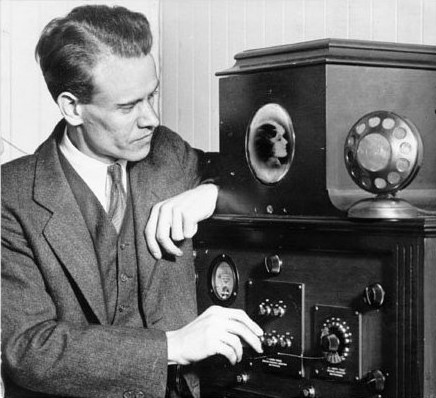

- © 2003 - 2025 Dynamix Productions, Inc. Contact Us 0



"If it weren't for Philo T. Farnsworth, inventor of television, we'd still be eating frozen radio dinners."
Johnny Carson
Eighty-six years ago, three musical tones, "G-E-C," were played on a fledgling network of radio stations. What started as a technical cue for local stations, has become an instantly recognized trio of notes woven into the American identity. NBC Radio's musical logo is no longer used as a cue, but can be heard almost every day on NBC Television.
There's some question as to what radio entity first used chimes to cue local stations for program changes, but NBC definitely perfected it. They experimented with several combinations, one of which was seven chimes long. Radio hosts were expected to dutifully play the chimes in correct order without error. That was never going to happen, so they shortened it to four. Evidently that was still too complicated, and so history was rung in on November 29, 1929 with "Bong, bong, bong."
During this time and even today, announcers were using strict phrases to cue local stations, such as "This is the NBC Radio Network." (I wrote about this in detail in this article). But busy station personnel would not always hear the vocal cues. NBC tried sending cues on teletype, but that didn't work. Eventually, engineers found that radio hosts could recognize simple tones as their cue. The NBC executives also liked it, because a musical identity would be a great branding tool.
Humans played the small xylophone-like chimes, albeit erratically, until 1932 when an automated machine was put into service. That music box-like unit was the brainchild of Richard Ranger, the father of the "modern" fax machine. The cue tones were eventually replaced with silent automation cues in the 1970's. Some radio and television affiliates continued to use the tones within newscasts for years. One holdout, WNBC-TV, still uses it today.
There has been one noteworthy alteration of the tones over the years – the fourth tone. In the early 1930's NBC executives needed a way to alert key network personnel that they were needed, such as in an emergency. They shifted to another key, G-major, and repeated the third tone. The sequence was played every 15 minutes until the necessary key people would check in. It was an early paging system.
The four tones eventually morphed into a special alert for radio stations and listeners that urgent programming was to follow. The Hindenburg disaster and the Pearl Harbor attack were notable examples. The four-tone alert was officially retired with the end of World War Two. It was played one last time in 1985 when NBC merged with General Electric.
The musical sequence of G3-E4-C4 is as familiar to Americans as Yankee Doodle. In music training, it's used to familiarize students with a major 6th interval (G3-E4) and a C-major chord in second inversion. It's been used in songs by Ray Charles and Isaac Hayes. It's been used in NBC slogans ("Chime in"). It's even been worked into sound effects on NBC -TV shows such as The Office (phones ringing) and Deal or No Deal (cash registers).
There are many songs that are part of the American psyche – God Bless America, This Land is Your Land, Take Me Home Country Roads, Take the A Train, America the Beautiful, and The Star Spangled Banner. They say less is more, and this simple three-tone song is a heavyweight among all American songs.
Here are some great links to the history of the NBC chimes.
The NBC Chimes Museum
History of the NBC Chimes
Listen to NBC Chimes past and present
NBC chimes machine
An electrical design for generating the NBC Chimes